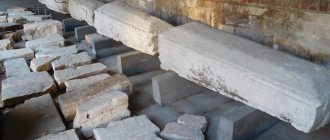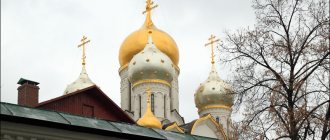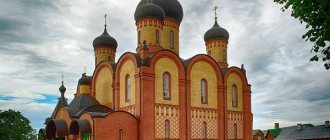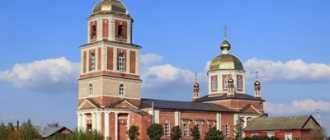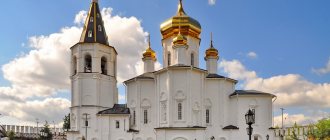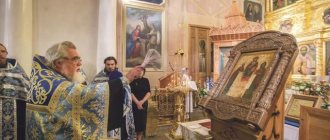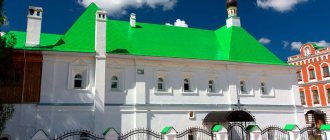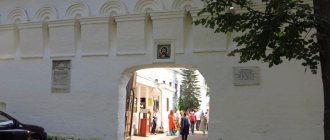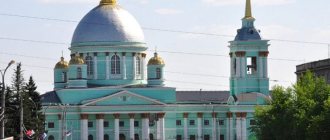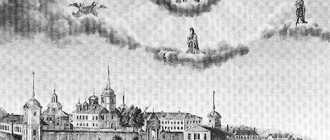| Zaikonospassky Monastery. Cathedral of the Savior Not Made by Hands, view from Revolution Square. September 20, 2013 |
Zaikonospassky Monastery in Moscow
, stauropegial monastery of the Russian Orthodox Church
- Address: Russia, 103012, Moscow, st. Nikolskaya, 7-9 (metro station "Teatralnaya")
- Telephone
- On the map: Yandex.Map, Google map
The monastery was founded in 1600 by Tsar Boris Godunov.
The first mention in historical documents dates back to 1635. The name “Zaikonospassky” is explained by its location behind the icon row, located along Nikolsky Street. Since 1665, a school was established in the monastery, headed by Simeon of Polotsk. The school trained officials for government agencies. In 1685, the Slavic-Greek-Latin Academy was opened in the premises of the monastery, headed by the brothers Ioannikis and Sophronius Likhud, famous in Russian history. Many Church leaders, scientists, and writers came out of the academy. In 1814, the academy was transformed into the Moscow Theological Academy and transferred to the Trinity-Sergius Lavra, and the Zaikonospassky Theological School remained in the monastery. The main temple of the monastery - the Spassky Cathedral - was built in 1660 by order of Emperor Alexei Mikhailovich Prince. F.F. Volkonsky. Consecrated in 1661, November 20. The current cathedral arose on the basis of this building. The exact date of its construction is unknown (presumably dates back to 1711-1720; the bypass gallery on columns dates back to the second quarter of the 18th century). Belongs to the monuments of the circle of I.P. Zarudny (in details there is a similarity with such structures as the Menshikov Tower and the Church of St. John the Warrior on Yakimanka). This is a tiered, cross-shaped temple of the octagon-on-quadrangle type, in the decoration of which the main role is given to elements of the classical pilaster order.
| Zaikonospassky Monastery. Cathedral of the Savior Not Made by Hands. September 20, 2013 |
In 1737, the temple was severely damaged by fire, but was restored under Elizabeth Petrovna by the skilled craftsman I.F. Michurin. Empress Elizaveta Petrovna, having arrived in Moscow for the coronation, personally ordered the restoration of the cathedral and in the summer of 1742 attended its consecration. Then the upper altar was consecrated in honor of the icon of the Mother of God “Joy of All Who Sorrow.” And the next year the Holy Gate, facing Nikolskaya, was crowned with a bell tower.
In 1812, the entire monastery complex was badly damaged during the invasion and atrocities of the French army. The temple was renovated in 1851, when an elegant onion-shaped dome-rotunda appeared on the dome of the cathedral.
At the top there was a side-chapel in honor of the icon of the Mother of God of the Joy of All Who Sorrow. This church is the same as the main one. Its walls are richly painted inside with images of the events of the Old and New Testaments, behind the left choir is a church pulpit in the form of a “pillar”, the icons are richly decorated. The entrance to the lower cathedral church in honor of the All-Merciful Savior comes from the monastery courtyard. The first impression upon entering the temple is its extraordinary darkness, the almost complete absence of daylight due to the fact that this low temple is surrounded on three sides by high two-story and three-story monastery buildings. The temple is supported by four stone pillars.
The cathedral kept a copy of the miraculous Vladimir Icon of the Mother of God in a Golden Robe, donated by Count N.P. Sheremetev, whose Moscow family home was located on Nikolskaya Street. On the feast of the Vladimir Icon on May 21, a religious procession was held here from the Assumption Cathedral in memory of the deliverance of Moscow from the invasion of the Crimean Khan Makhmet-Girey in 1521.
In the 1920s, the temple became the center of the renovationist “Union of Church Revival”, and in 1929 it was closed.
The temple building housed various government institutions. In the 1960s the building of the closed cathedral was restored. The upper tier was rebuilt - lucarnes were made in the roof, a decorative fence was installed on the 3rd and 4th tiers, etc. Instead of a cross, a gilded pin was erected.
The temple was returned to the Church in 1992. Services resumed in July of the same year. The temple has the status of a patriarchal courtyard. The bell towers of the former Zaikonospassky and former St. Nicholas-Greek monasteries were assigned to the temple.
On March 5, 2010, the Holy Synod decided to open the Zaikonospassky stauropegic monastery in the city of Moscow, separating it from the Patriarchal metochion of the former Zaikonospassky and Nikolsky monasteries in Kitai-Gorod, Moscow.
Statistics
- January 2012 - approx. 20 monks (5 monks, 4 monks, novices) [1]
Abbots
- Macarius (mentioned 1620) abbot.
- Varlaam (mentioned 1634 - 1644) abbot.
- Paphnutius (1645 - mentioned 1647) abbot.
- Misail (mentioned 1650 - mentioned 1653) abbot.
- Joseph (mentioned 1675 [2] - mentioned September 9, 1676 [3]) archimandrite.
- Sylvester (Medvedev) (mentioned August 25, 1680) [4]
- Lucian (? - 1700) abbot.
- Palladium (Rogowski) (1700 - January 23, 1703)
- Rafail (Krasnopolsky) (1703 - early 1704)
- Sylvester (Kraisky) (1704 - March 11, 1705)
- Anthony Carmelite (1705 - 1706)
- Joseph (Turoboysky) (1706 - 1708)
- Theophylact (Lopatinsky) (1708 - 1722)
- Gideon (Vishnevsky) (1723 - 1728)
- German (Koptsevich) (1728 - 1731)
- Sophrony (Migalevich) (May 2, 1731 - August 16, 1732)
- Theophylact (Zhurovsky) (August 30, 1732 - December 12, 1733) hierome, high-ranking
- Peter (Afanasyev) (March 5, 2010 - April 11, 2016)
- Daniil (Konstantinov) (from June 8, 2016) acting governor
Academy
But the real rise of this religious educational institution began in 1665 thanks to the efforts of its then rector, Simeon of Polotsk. What the worldly name of this monk was is unknown. Only his last name has been preserved - Sitnianovich-Petrovsky. They began to call him Polotsk after his former place of service. This monk transformed an ordinary “public” monastery school with semi-literate teachers into a serious educational institution.
The first attempt to create a real Academy within the walls of the Zaikonospassky Monastery was made in 1680 by abbot Sylvester Medvedev. This monk petitioned Tsar Fyodor Alekseevich for its opening. However, the sovereign soon died, and therefore it was not possible to carry out his plans.
In 1687, the Hellenic-Greek school was moved to the Zaikonospassky Monastery from the Epiphany. It was created by the Likhud brothers, recommended to the Russian Tsar by the Eastern Patriarchs. These monks were descendants of the Byzantine royal family and were trained first in Greece and then in Venice. After the transfer, the Academy was given the name Slavic-Greco-Latin. For a long time it remained the only higher educational institution in the state. Its rectors were the archimandrites and abbots of the monastery. Many famous Russian scientists, including Mikhail Lomonosov, studied within the walls of this institution.
Literature
- Beldova M.V., Vorobyova Yu.S., Zhukova M.P. and other comp.; Innokenty (Prosvirnin), archim., scientific director.. History of the Russian Orthodox Church in documents of the Federal Archives of Russia; Archives of Moscow and St. Petersburg: Annotated directory-index.. Moscow. Novospassky Monastery. 1995. 397,[3] p..
- Sudarikov A.V., Chapnin S.V.. Orthodox Moscow: Directory of existing monasteries and churches.. M.. Brotherhood of St. Tikhon. 1993. 224 s..
- Chapnin S.V.. Orthodox Moscow: Directory of existing monasteries and churches.. Moscow. Publishing house of the Brotherhood of St. Tikhon. 1999. 256 pp..
- Nikolaeva T.E., Sudarikov V.A., Chapnin S.V.. Orthodox Moscow: Directory of monasteries and temples. M.. Publishing house of the Brotherhood of St. Tikhon. 2001. 320.
ZAIKONOSPASSKY IN HONOR OF THE MIRACULOUS IMAGE OF THE SAVIOR MOSCOW MONASTERY
According to documents from the 20-50s. In the 17th century, on the territory of Z. m. there was a stone, apparently Spassky, cathedral and a wooden church.
The new stone Spassky Cathedral was built in 1660 at the expense of the boyar Prince. F. F. Volkonsky. The lower church was consecrated in honor of the Image of the Savior Not Made by Hands, the upper one in honor of the icon of the Mother of God “Joy of All Who Sorrow.” The date of construction is confirmed by the inscription on the foundation stone, the full text of which could be read in the 18th century: “In the summer of April 7168 [1660], on the 30th day, construction began on the Church of the All-Merciful Savior of the Not Made by Hands by order of... the king... Alexy Mikhailovich... built according to the promise his boyar, Prince Feodor Feodorovich Volkonsky, and was committed in 7169 [1660], on the 20th day of November" (see: Damascene. 1791. P. 200). In 1701, the temple was damaged by fire, and in the same year a refectory was added to it (Monuments. 1982. p. 418). By 1702 there were 2 contract agreements (dated April 30 and September 24) with the abbot. monastery Palladium for dismantling and rebuilding a church of unknown dedication (Dictionary of Architects. 2008. P. 261; RGADA. F. 282. Op. 1. Part 1. D. 1031. L. 677-677 vol., 869; Nikolaeva M.V. Iconostases of churches in Moscow and the Moscow region of the 1st quarter of the 18th century: History of creation - “carpentry and carving” // Christian architecture: New materials and research. M., 2004. P. 406). It is unknown which temple is referred to in the agreement dated September 17. 1702 about making an iconostasis for a newly built church (Dictionary of Architects. 2008. P. 261), because by that time the church had not even been dismantled.
Cathedral in honor of the Image of the Savior Not Made by Hands. 10 Cathedral in honor of the Image of the Savior Not Made by Hands. 10 In June 1709, Archimandrite. Monastery Theophylact in a report to Tsar Peter I reported that the construction of the temple had not yet been completed “due to a shortage of iron and other supplies” (RGADA. F. 214. Siberian order. Op. 5. No. 1545. L. 1). An undated report from the archimandrite reported that in the same year, “two hundred barrels of the sovereign’s lime” were borrowed “for the completion of the church of the Spassky Monastery” (RGADA. F. 9. Cabinet of Peter I. Dept. 2. Book 22. L. 146). Thus, the surviving Spassky Cathedral was probably built in the 10s. XVIII century (Dictionary of Architects. 2008. P. 262). In 1721, his figure of eight was already considered as an architectural model (Ibid. p. 486). In documents of the 10-30s. XVIII century a chapel in the name of the Great Martyr is mentioned. Theodore Tyrone in the Sorrow Church (perhaps it already existed in the temple in 1660, since the Great Martyr Theodore could be the namesake of the builder of the temple, Prince Volkonsky). The cathedral was again damaged during the fire of Moscow in 1737; Upon completion of repair and construction work, handy. architect I. F. Michurina was consecrated on July 15, 1742 by the Archbishop of Novgorod and Velikolutsk. Ambrose (Yushkevich) in the presence of the Emperor. Elizaveta Petrovna. During the renovation, 2 floors of cells for academy students were built under the porch on the west and north.
The temple is one of the classic examples of Peter the Great's architecture in Moscow, which combined the forms that dominated Russian architecture with the Middle Ages. 80s XVII century Naryshkin style with the baroque that had just begun to penetrate from Europe (the decisive role was played by the Great Embassy of 1697-1698), mainly in its modest Protestant style. from. The lower temple has traditions. for the 17th century layout (quadrangle, altar with 3 apsidal semicircles, refectory); 4 pillars in the west. parts of the main volume were probably installed during the superstructure of the upper temple. The latter is a quadrangle topped with 2 octagons, the smaller of which bears a small dome. The Z. M. Cathedral is one of the first churches in Moscow, in which the so-called. small octagon - significantly inferior to the quadrangle in width and resting not on the walls of the quadrangle, but on the vaults erected above them. The central spindles of the quadrangle, flanked by pilasters, protrude strongly from the plane of the walls, giving the volume a cruciform character; the projections are completed with semicircular pediments (so-called semi-domes), visually facilitating the transition to the octagon. A similar role is played by the small semi-domes and 4 lucarnes, arranged in the vault of the lower octagon. The lower part of the quadrangle is surrounded by a covered walkway; passages, limited by light balustrades, are also located along the edges of the quadrangle and at the base of the lower octagon (in the latter case, not only outside, but also inside).
In terms of architecture, the temple is close to a number of Moscow churches of Peter the Great's time, primarily to the C. John the Warrior on Yakimanka (1709-1717) and the Cathedral of the Barsanuphius Monastery (1709-1714, consecrated in 1730, not preserved). Some researchers believed that the architect of the temple was I.P. Zarudny (Russian architecture. 1954. pp. 64-69, 73-76); this t.zr. has not received documentary confirmation (Dictionary of Architects. 2008. P. 250) and cannot be accepted (Architects of Moscow from the time of Baroque and Classicism (1700-1820s). M., 2004. P. 96).
The old iconostasis of the upper Sorrow Church, as well as the utensils of the dilapidated chapel of the Great Martyr. Theodore Tiron, burned down in a fire in 1737. Probably, after the fire this chapel was abolished. According to the description of 1781, in the upper Skorbyashchenskaya church. there was a wooden carved gilded 4-tier iconostasis, which was preserved by the newer one until the beginning. XX century The choir and preaching pulpit were richly gilded towards the end. XIX century The high, light-filled interior space of the temple was surrounded on 3 sides by choirs, which in the present day. time converted into balconies inside the protruding spindles. The upper temple was entirely painted with scenes from the “Old Testament and New Testament history. Light flows abundantly into this temple from the glass gallery, dormers and dome; the eye of the person praying pleasantly pampers the blue background of the wall painting of the temple” (Kovalyov. 1887. P. 92).
In con. XVIII century in the lower Spasskaya Ts. there was a 2-tier “stone painted and sometimes gilded” iconostasis. The wooden royal doors with 6 images were also painted and gilded in places. The temple icon “Savior Not Made by Hands” was decorated with a silver crown, and in 1793 with diamonds and emeralds (RGADA. F. 1189. Op. 1. No. 334. L. 77).
In 1812 the French. soldiers destroyed and desecrated the Spassky Cathedral, setting up a stable in it; then it was restored; rebuilt in 1851 (the shape of the chapter was changed) and in the 2nd half. XIX century
According to the description of the beginning. XX century, in the altar iconostasis of the lower church there were icons of the Holy Image of the Savior in a silver robe, the Mother of God in a silver robe, the VMC. Catherine, St. Mary Magdalene before the Crucifixion, St. ap. John the Evangelist, St. blgv. book Alexander Nevsky, the apostles Peter and Paul, as well as a picturesque image of St. John the Baptist with banners or unfolded paper scrolls. On the walls of the altar there are picturesque images of the Nativity of Jesus Christ, Saints Nicholas the Wonderworker and Spyridon of Trimifuntsky. Among the shrines behind the right choir, in a small icon case, particles of the relics of the apostles Andrew the First-Called and Barnabas, the First-Called, were kept. archdeacon Stephen, St. Spyridon of Trimifuntsky, St. Michael of Sinadsky (Phrygian), martyr. Andrei Stratilat, mts. Salome, prmch. and Spanish Stephen the New, St. blgv. led book Basil of Yaroslavl, Saints Pimen the Great and Macarius of Kalyazin. Here also was kept an icon case with particles of the relics of saints, particles from the stone on which “the Angel would proclaim the Resurrection of Christ,” and 2 stones from the “Pillar of the Lord.” By 2008, the original decoration and paintings of the temple were completely lost.
The description, which indicates the size of the site and the approximate topography of the buildings of the monastery, is contained in the census of the courtyards of Kitay-gorod after the fire of Moscow in 1626. According to the census, the monastery was located along Nikolskaya street, occupied 14 fathoms, in depth , to the Kitaygorodskaya wall, - 16 fathoms; the wooden monastery church protruded onto the street line, and at 8 fathoms. from it in the courtyard there was a stone church 6 fathoms long. To the east of the Z. m. the Nikolskaya monastery is indicated. Both monasteries share wooden cells, separated from the altar of the stone temple by 1.5 fathoms. The land to the west of Z. m. belonged to the Zemsky Dvor. In 1626 it was rented by private individuals. The courtyard closest to the mon-rue was separated from the street by 9 trading shops of the Icon Row. Thus, at the beginning XVII century The monastery was small and, apparently, its formation was just beginning.
K ser. XVII century here there was a school building “for grammatical teaching,” and in 1665 special wooden mansions were built for the school of Simeon of Polotsk (RIB. T. 23. Cases of the Secret Order. Stb. 638, 649). In 1681, “for the establishment of ... the academy,” it was planned to add “the land near that monastery to the Neglinny Gates in length by 18 fathoms, across by 15 fathoms” (RGADA. F. 18. No. 85. L. 507).
In 1685, on a plot of land from the Zemsky Dvor, adjacent to the Mont-Rue from the west and given to it by Peter I, a grandiose 3-story stone collegium (academic building) with galleries and a square staircase tower at the southwest was built. corner topped with an octagon. The diplomat de la Neuville in “Notes on Muscovy” in 1689 called the building “huge and beautiful.” In 1819, architects M. F. Kazakov [L. K. Carloni?] and O.I. Bove proposed to dismantle the building. A new 3-story school building was built in 1821-1822. in the Empire style according to the design of Bove (sometimes mistakenly attributed to the architect V. Yakovlev); The old foundations were used, but the building expanded significantly towards the wall of China Town.
To the north of the temple, in line with the collegium, there was a 2-story fraternal building. This complex building was built at the turn of the 17th and 18th centuries. (traditionally dates back to 1686; a document of 1702 is known about the issuance of money to the former Ryazan Metropolitan Abraham for the construction of stone and wooden cells). The lower floor was intended for household needs, while the living rooms were located upstairs. By decree of Peter I in 1718 in the north. Along the line of buildings, 2-story teachers' cells were built, reminiscent of a fraternal building (together with the Crimea they were called the teachers' building): the contract for their construction “according to the first drawing, which was made by Ivan Zarudnev” was concluded in 1720 (Dictionary of Architects. 2008. P. 499). In 1729 along the south. the walls erected a gallery that visually united the teachers' cells and the college. The Teachers' Building has been preserved: the western part (cells) was rebuilt at the turn of the 18th and 19th centuries, the large eastern part - in 1886 in Russian forms. style (architect N.A. Sher) with the addition of a 3rd floor.
In 1784 to the west. In part of the courtyard, a 2-story bursa building was built (dismantled in 1895).
From Nikolskaya street. St. was led to the monastery. gates with wings on both sides; through them we got to the platform in front of the south. entrance to the temple, as well as to the covered gallery of the upper temple. In 1743 the gate was rebuilt and topped with a bell tower. To the west there were school gates leading to the monastery courtyard, along the south. along the side of it stretched a one-story building with an icon row. The right to own the building was given to the mon-ru by decree of Tsar Peter I on February 12. 1718, confirmed by a charter from the Emperor. Peter II from 9 Oct. 1728 In 1753, by order of the Emperor. Elizabeth Row was demolished “so that the street would not be crowded”; Instead, it was ordered to build 2 stone chambers, commensurate with the side wings of St. gate In 1781, after dismantling the dilapidated fence between the bell tower and the Greek monastery, a 2-story building was built in Z. m. White stone pipes were laid in the foundation of this building to drain water from Nikolskaya Street. through the territory of the monastery to Neglinka. On the lower floor of the building there were a stable and a carriage house, on the 2nd floor there were 2 cells with an entrance (RGADA. F. 280. Op. 17. No. 89. L. 1-14).
At the turn of the 19th and 20th centuries. along the new red line Nikolskaya street. 2 monumental houses were built, which have survived to this day. time. To the west of the school gates, the Trading House (1899-1901, architect M. T. Preobrazhensky) was erected in Russian. style, decor and high roofs are similar to the Upper Trading Rows building located on the opposite side of the street (1890-1893, architect A. N. Pomerantsev). To the east, in the same style, but in a version imitating Naryshkin forms, a monastery apartment building was built (1900, architect Z. I. Ivanov); above the St. opening built into the central part of the facade. gate (now laid down), a bell tower was erected (the top was dismantled in 1924), which copied the completion of the bell tower of the Moscow Church of the Assumption on Pokrovka (1696-1699; not preserved). The houses completely separated the monastery from the street and significantly reduced the space of the yard.
A. V. Mashtafarov, L. K. Maciel Sanchez
Used materials
- Stroev P.M., Lists of hierarchs and abbots of monasteries of the Russian Church. - St. Petersburg, 1877, stb. 158-162.
- History of the Zaikonospassky Monastery // Official website of the male stauropegial monastery in Moscow:
- (material used partially)
[1] Olga Bogdanova, “Hegumen Peter (Afanasyev): We must love everything that the Lord gives,” Tatyana’s Day
(online edition), January 20, 2012,
[2] Mentioned with the title of builder (Stroev, Decree op.
Art. 158.)
[3] Referred to as archimandrite. See Evgeniy (Bolkhovitinov), Metropolitan. Historical dictionary. About the writers of the clergy of the Greek-Russian Church who were in Russia
, Volume II. - Moscow: Publishing house "Russian Court", Holy Trinity Sergius Lavra, 1995, p. 254, 287.
[4] Evgeniy (Bolkhovitinov), Metropolitan. Historical dictionary. About the writers of the clergy of the Greek-Russian Church who were in Russia
, Volume II. - Moscow: Publishing house "Russian Court", Holy Trinity Sergius Lavra, 1995, p. 254, 287.
Foundation of the monastery
In the 14th century, on the site of Zaikonospassky, the monastery of St. Nicholas of Spassky was located. Unfortunately, very little information about this complex has survived. It is only known that the western section was once separated along with the church that stood here. A new religious center on this site was probably founded in 1620. Since the Icon Trading Rows began right behind it, it was named Zaikonospassky.
According to other sources, Prince Volkonsky founded the Zaikonospassky Monastery by order of Tsar Alexei Mikhailovich in 1600. In any case, by 1626 there were two churches behind this center - a stone one and a wooden one, as well as cramped cells arranged in even rows. The first documentary mention of this monastery dates back to 1635. In those days in Moscow this monastery was called “teachers’ monastery.” He enjoyed simply exceptional respect in the capital.
Completion of construction
About a year later, the construction was completed, which brought great joy and happiness to the believers. The temple turned out to be incredibly beautiful, very bright and spacious. In 1721, its appearance was taken as an architectural template for the construction of other temples. In 1737, the cathedral again suffered an unpleasant event: it was that year that a large-scale fire occurred in Moscow, during which the monastery was also damaged. After the fire, active restoration of the temple began under the leadership of architect Michurin. The work lasted for more than one year. At the end, the temple was consecrated again.
Lost Wealth
Studying the descriptions of the early twentieth century, you can find out that the temple had a huge number of miraculous icons that were in the silver sacristy. Few monasteries in Moscow could boast of such wealth. Nativity and many other beautiful scenes are depicted near the walls of the altar. The master tried so hard that all the images look alive. The temple also houses a huge number of relics of saints, which are famous for their miraculous effects. Unfortunately, all this spiritual wealth was completely lost by the beginning of 2008.
Interior decoration
You can also learn a lot of interesting things from the description of 1781. Thus, in the lower church there was an incredibly beautiful gilded iconostasis, which was preserved until the twentieth century. The space of the temple was flooded with sunlight, and there were choirs along three walls. Today, the location of the choirs has been moved. An incredible amount of work and talent was invested in the upper temple; the walls were completely painted with scenes. A huge amount of light penetrated here, thanks to which all the images seemed to come to life and also rejoice in the sun. But in the evening, by candlelight, the faces seemed more stern.
At the end of the 17th century, some changes took place in the temple. The Spasskaya Church houses a magnificent stone iconostasis. The royal doors, made of wood, were covered in places with gilding to emphasize the majesty of the icons. But for the icon “Savior Not Made by Hands” a stunning silver crown was made. In 1812, an outrageous event occurred. During Napoleon's invasion, the temple was again desecrated and looted. The French soldiers set up a stable in the church and settled their tailors in the cells. The joy of the invaders was short-lived. However, it was possible to renovate the temple only in 1851. The cathedral was completely restored, and services began here again.
Monuments of church antiquities
During numerous disasters and reconstructions, many valuables were damaged or lost for various reasons. Thus, during the Moscow fire, the sacristy of the monastery suffered the most, but that was not the end. After restoration, as is already known, the temple was captured by the French, which again brought enormous harm and destruction.
In 1813, Archimandrite Simeon carried out a reconciliation of the temple’s property, during which it turned out that there were not a huge number of icons, jewelry and silver crosses. Among these crosses there was one unique one, it contained 420 particles of the relics of various saints, and there was also a pendant with particles of the Lord’s robe. Thus, a huge number of unique things that simply have no analogues disappeared from the temple. All these things were sold or simply destroyed. Today, perhaps, something remains, but it is in private collections and, probably, will not return to the monastery. But still some things were saved.
The monks are trying to maintain the building so that it can live for many more centuries and amaze new generations with its beauty and majesty, and the walls of the academy can once again produce unique people devoted to their spiritual calling. From the first steps you can feel a special energy within these walls. The temple has had its share of many trials, but to this day it operates. The service in the Zaikonospassky Monastery ascends from heaven every day, and it will continue to do so for centuries to come.
